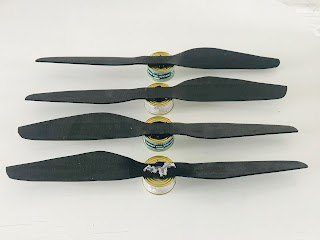For the purposes of the prototype at least I elect to mount the motors inverted on the upper quad... the upper quad itself may yet feature underslung power units in addition to top-mounted in order to provide a necessary failure redundancy for human carriage but for now it is more a case of extracting every last ounce of thrust from the motors we have available.
In all drones there are losses incurred from the imposition of cantilevers in the efflux of the propellers, and by mounting them underneath these losses are absolved. There may be losses incurred from having moved the uppermost propeller that bit nearer to the lower, but instinct suggests that these will be negligible.
The efflux from a propeller is shaped like the horn of a trumpet in that it progressively narrows on departure to form a column somewhat smaller in diameter. Manufacturers of motors caution that up to 25% of thrust might be lost when motors are mounted in pairs one above another.
The only research I have seen on this found that once the lower propeller is around a third or half of the propeller diameter removed, losses are diminished altogether. This suggests that once our propellers on upper and lower quad are separated vertically by at least a foot, there is nothing to be gained by removing them further.
This aside, following the disappointment of our last test-flight I pledged to return to the drawing board and both redesign and rebuild a prototype that has more than an evens chance of success ~ and within the course of a month.
And this is it.
































